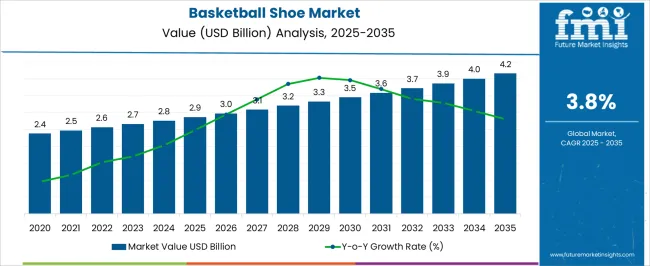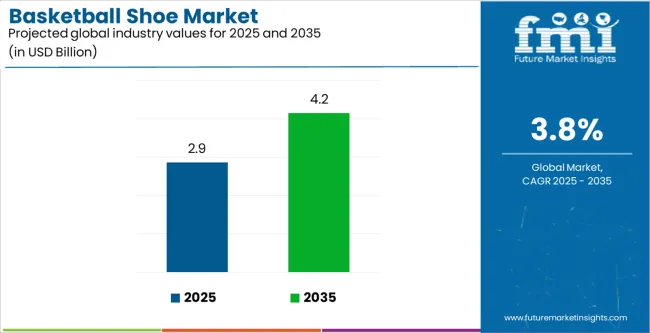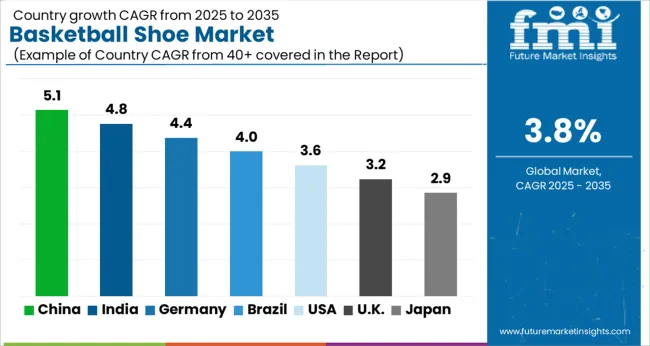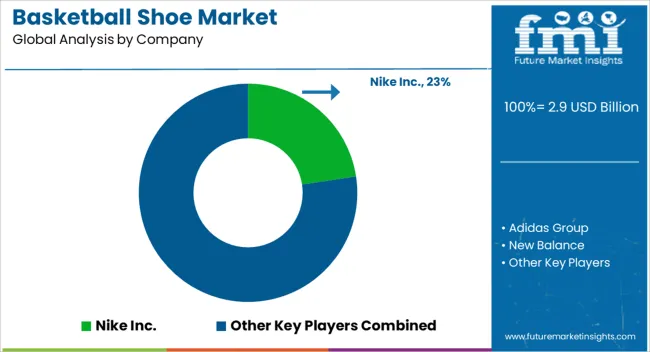The Basketball Shoe Market is estimated to be valued at USD 2.9 billion in 2025 and is projected to reach USD 4.2 billion by 2035, registering a compound annual growth rate (CAGR) of 3.8% over the forecast period.
The basketball shoe market is advancing steadily, supported by rising sports participation, evolving fashion trends, and performance-driven footwear innovation. Industry news and athletic brand reports have emphasized the growing influence of basketball culture beyond the court, fueling consumer interest in technical shoes that blend athletic performance with everyday wearability.
Product development initiatives have increasingly focused on advanced cushioning, lightweight materials, and ankle stability, all of which align with athlete safety and comfort expectations. Meanwhile, collaborations between athletes and global footwear brands have created aspirational demand across both competitive and recreational segments.
The expansion of online retail and digital marketing platforms has also played a vital role in expanding brand visibility and product accessibility, especially among Gen Z and millennial consumers. Looking forward, market momentum is expected to be reinforced by smart shoe technology integrations, personalized fit systems, and limited-edition releases that combine innovation and exclusivity. Segmental leadership is being driven by High-Top Shoes for product type, Sports for application, and Laces for closure type each backed by functional value and user familiarity in both athletic and lifestyle contexts.


| Metric | Value |
|---|---|
| Basketball Shoe Market Estimated Value in (2025 E) | USD 2.9 billion |
| Basketball Shoe Market Forecast Value in (2035 F) | USD 4.2 billion |
| Forecast CAGR (2025 to 2035) | 3.8% |
The market is segmented by Product Type, Application, Closure Type, Consumer Orientation, and Sales Channel and region. By Product Type, the market is divided into High-Top Shoes, Mid-Top Shoes, and Low-Top Shoes. In terms of Application, the market is classified into Sports, Lifestyle, and Competition. Based on Closure Type, the market is segmented into Laces, Velcro, Straps, and Zippers. By Consumer Orientation, the market is divided into Men and Women. By Sales Channel, the market is segmented into Online Retailers, Multi-Brand Stores, Independent Small Stores, and Other Sales Channels. Regionally, the market is classified into North America, Latin America, Western Europe, Eastern Europe, Balkan & Baltic Countries, Russia & Belarus, Central Asia, East Asia, South Asia & Pacific, and the Middle East & Africa.

The High-Top Shoes segment is projected to hold 42.7% of the basketball shoe market revenue in 2025, establishing itself as the leading product type. This leadership has been shaped by the product’s core function in providing enhanced ankle support and injury prevention an essential factor for high-impact court play.
Athletic trainers and footwear designers have continually endorsed high-top silhouettes for their protective features, particularly among competitive and amateur players. Additionally, the aesthetic appeal of high-tops has extended their popularity into streetwear and urban fashion markets, broadening the customer base.
High-top designs have also benefited from brand collaborations with professional athletes, which have reinforced their performance credibility and market visibility. As performance expectations and style preferences converge, the High-Top Shoes segment is expected to maintain its edge through product innovation and cultural relevance.

The Sports segment is anticipated to contribute 39.4% of the basketball shoe market revenue in 2025, solidifying its role as the primary application category. Growth in this segment has been driven by the consistent demand for purpose-built footwear that enhances athletic performance during training and games.
Sports science publications and athlete interviews have highlighted the need for basketball shoes that deliver stability, grip, and energy return, all of which are critical in high-intensity play. Brands have responded with specialized midsoles, improved traction outsoles, and breathable upper materials designed for court dynamics.
Youth basketball programs and increased participation in competitive sports have further fueled this demand across various age groups. The segment has also seen strong support from sponsorships and league endorsements that promote the use of performance-oriented footwear. As competitive play continues to rise across regions, the Sports segment is expected to remain a key contributor to market growth.

The Laces segment is projected to account for 51.2% of the basketball shoe market revenue in 2025, positioning it as the most widely adopted closure type. This dominance has been influenced by the adjustability, familiarity, and secure fit that traditional lacing systems provide.
Athletes and trainers have continued to favor laced closures for their customizable tension and ankle-locking capabilities, which are essential during abrupt lateral movements and high jumps. Footwear design updates have preserved the lace system while enhancing ergonomics with features like dynamic lacing zones and integrated loops.
In addition, the aesthetic and nostalgic appeal of classic lace designs has been retained in both performance and lifestyle models. Although alternatives such as zippers and slip-on configurations have gained niche traction, laces remain the preferred standard due to their proven utility and wide user acceptance. With continued advancements in lace materials and integration with upper construction, the Laces segment is expected to maintain its stronghold in the basketball shoe market.
Resurgence of Retro Designs to Impact the Basketball Shoe Sector
The basketball shoe industry is witnessing a resurgence of retro designs. These designs have been reimagined with modern performance features. Thus, creating a blend that appeals to modern basketball requirements and nostalgia. These designs have gained appeal among Generation Z, a group recognized for their distinct aesthetic sensibilities, who are intrigued by a mix of new and old styles.
The popularity of this trend is further amplified by endorsements by fashion icons and celebrities, who have made retro-styled basketball shoes mainstream from a niche interest. Thus, marking a prominent shift in fashion trends.
Players to Play Along Smart Technology to Smarten their Offerings
Basketball shoes are being integrated with smart features. Brands like Nike are emerging as frontrunners when it comes to technology like embedding sensors and connectivity options that give data about real-time performance.
For instance, Nike Adapt BB revolutionizes the industry with its self-lacing mechanism, FitAdapt technology, and pressure sensors, all managed with a smartphone app.
With the help of this technology, brands not only enhance product performance but also provide valuable insights for more design enhancements. These technological advancements showcase technologies’ potential to elevate athletic performance.
Women Players to Increase in Future
Participation of women is expected to surge in sports, due to reasons like fitness and health. As more women play sports to enhance their lifestyles and health, the demand for female-oriented basketball sneakers is expected to gain wider attention.
Another driver for women in sports is the support given by esteemed organizations to promote women's participation in sports. Schools take an interest in promoting their female students to play as a hobby, or in inter or intra-school competitions.
Global basketball shoe sales rose at a CAGR of 3.4% from 2020 to 2025. Through 2035, the industry is projected to expand at a 3.8% CAGR. The market is primarily driven by the surging interest in basketball, especially among the younger generation.
This athletic footwear is particularly designed to optimize performance while playing basketball. Focus is given to aspects like comfort, support, stability, and traction to reduce the likelihood of injuries while playing this high-impact and fast-paced sport. These factors drive the sales of basketball shoes among amateur or professional basketball players.
Basketball shoes are a profitable section of the athletic footwear industry, characterized by its constant celebrity endorsements, innovations, and a large fan base. Leading brands intensely compete in this market, introducing the latest designs and technologies to enhance performance and style to reflect the sport’s cultural significance.
The increasing popularity of professional basketball leagues, especially the NBA, and the impact of eminent athletes in influencing customer preferences and likes are key drivers for this industry.
Top brands are further enhancing basketball shoe designs with technological improvements like lightweight materials and improved cushioning. Performance-driven and fashion-forward basketball shoes are a key component of the athletic footwear landscape, serving professional players as well as a wider consumer base.
The table below offers quantitative insights into the adoption of basketball shoes in key markets. Upon inspection, it can be concluded that developed countries like Germany and the United States have started showing moderate sales of basketball shoes, as the market is becoming mature. Meanwhile, the demand potential for basketball shoes is significant in countries of Asia Pacific.

Basketball enjoys wide popularity across the United States. Since basketball originated in the country in 1891, this sport is a matter of national pride. Basketball is present everywhere, from professional and college leagues to elementary school playgrounds. Their widespread popularity has accelerated the demand for basketball shoes among basketball players.
The National Basketball Association (NBA) also plays a key role in popularizing basketball across the country. It does so by employing innovative promotions and marketing. Thus, developing campaigns that resonate with fans across the globe.
The campaigns also feature shoes from leading brands like PUMA, Jordan, Nike, etc. Sales of basketball shoes in the United States are expected to expand at a 4.3% CAGR over the forecast period.
Even though basketball is a comparatively less famous sport in India than cricket and football, the last few years have been critical for basketball’s popularity. NBA is marketing basketball in India.
The association is also providing help in terms of training and infrastructure. The association entered India in 2020 by establishing a basketball school in Mumbai. The association has since expanded across NCR, Greater Noida, and Pune.
Good reception of basketball in India is fueling the sales of basketball shoes in the Indian economy. Basketball shoe brands hold a lot of potential in India. By 2035, manufacturers can expect a growth rate of 8.3%.
The basketball shoe sector in Australia is expanding at a CAGR of 6.8% over the forecast period. Basketball stars are inking contracts with popular brands to escalate brand recognition among the masses. New lines from leading brands like Converse, Nike, Adidas, etc. feature in-line styles and signature models.
Top brands sell their collection beyond their brick-and-mortar stores and on virtual platforms. These platforms stock responsive basketball shoe collections and also offer the facility of free delivery and returns. Players are further focused on the latest innovations and increasing performance style to increase sales of basketball shoes.
The section below provides key details about the growth drivers for leading segments in the industry. In the closure type segment, the laces type is expected to gain a massive share of 45.3% in 2025. By product type, the high-top shoe segment is predicted to obtain a prominent holding of 48.3% in 2025.
| Segment | Laces Type (Closure Type) |
|---|---|
| Value Share (2025) | 45.3% |
Lace-up shoes are the dominantly preferred and worn footwear. The basic tying mechanism of shoes with laces makes them durable and adjustable for wearers. Their high preference has led them to attain a share of 45.3% in the global market.
The snug fit of the shoe around the midfoot, afforded by these laces, enhances the feel and responsiveness of the court. Thus, allowing more control over movements.
Laces have a critical role in sports like basketball as they ensure that the shoe stays securely on the wearer's foot during explosive movements. For comparison, a slip-on shoe is likely to come off during a quick stop or a jump, leading to loss of momentum as well as potential injury.
| Segment | High-top Shoe (Product Type) |
|---|---|
| Value Share (2025) | 48.3% |
High-top shoes are expected to garner a share of 48.3% in 2025. These variety of shoes are quite popular among professionals in the game as they provide comfort and injury prevention capabilities. These shoes are extremely versatile when it comes to styling. This has magnified their demand among recreational and professional players across the globe.

Key players in the basketball shoe sector are employing various strategies to stir consumer interest. For instance, brands are investing in athlete endorsements as it is a proven way to capture consumer attention and foster brand loyalty.
While designing basketball shoes, players also take into account the latest fashion and streetwear trends to gain relevance among the masses. eCommerce trends are also impacting the basketball shoe market. Consumers are increasingly purchasing these shoes from online sites.
In basketball shoe manufacturing, players are investing in cushioning technologies and innovative materials to enhance their product offerings. Many players are now actively participating in sustainability initiatives, by using eco-friendly materials or partially using recycled content. Due to these aspects, they are drawing an eco-conscious crowd who play basketball.
Industry Updates
Based on product type, the industry is divided into high-top shoes, mid-top shoes, and low-top shoes.
By application, the market is trifurcated into sports, lifestyle, and competition.
Common closure types of basketball shoes include laces, Velcro, straps, and zippers.
Based on consumer orientation, the industry is bifurcated into men and women.
Various sales channels for basketball shoes include multi-brand stores, independent small stores, online retailers, and other sales channels.
The basketball shoes are sold across North America, Europe, Asia Pacific, the Middle East and Africa, and Latin America.
The global basketball shoe market is estimated to be valued at USD 2.9 billion in 2025.
The market size for the basketball shoe market is projected to reach USD 4.2 billion by 2035.
The basketball shoe market is expected to grow at a 3.8% CAGR between 2025 and 2035.
The key product types in basketball shoe market are high-top shoes, mid-top shoes and low-top shoes.
In terms of application, sports segment to command 39.4% share in the basketball shoe market in 2025.






Our Research Products

The "Full Research Suite" delivers actionable market intel, deep dives on markets or technologies, so clients act faster, cut risk, and unlock growth.

The Leaderboard benchmarks and ranks top vendors, classifying them as Established Leaders, Leading Challengers, or Disruptors & Challengers.

Locates where complements amplify value and substitutes erode it, forecasting net impact by horizon

We deliver granular, decision-grade intel: market sizing, 5-year forecasts, pricing, adoption, usage, revenue, and operational KPIs—plus competitor tracking, regulation, and value chains—across 60 countries broadly.

Spot the shifts before they hit your P&L. We track inflection points, adoption curves, pricing moves, and ecosystem plays to show where demand is heading, why it is changing, and what to do next across high-growth markets and disruptive tech

Real-time reads of user behavior. We track shifting priorities, perceptions of today’s and next-gen services, and provider experience, then pace how fast tech moves from trial to adoption, blending buyer, consumer, and channel inputs with social signals (#WhySwitch, #UX).

Partner with our analyst team to build a custom report designed around your business priorities. From analysing market trends to assessing competitors or crafting bespoke datasets, we tailor insights to your needs.
Supplier Intelligence
Discovery & Profiling
Capacity & Footprint
Performance & Risk
Compliance & Governance
Commercial Readiness
Who Supplies Whom
Scorecards & Shortlists
Playbooks & Docs
Category Intelligence
Definition & Scope
Demand & Use Cases
Cost Drivers
Market Structure
Supply Chain Map
Trade & Policy
Operating Norms
Deliverables
Buyer Intelligence
Account Basics
Spend & Scope
Procurement Model
Vendor Requirements
Terms & Policies
Entry Strategy
Pain Points & Triggers
Outputs
Pricing Analysis
Benchmarks
Trends
Should-Cost
Indexation
Landed Cost
Commercial Terms
Deliverables
Brand Analysis
Positioning & Value Prop
Share & Presence
Customer Evidence
Go-to-Market
Digital & Reputation
Compliance & Trust
KPIs & Gaps
Outputs
Full Research Suite comprises of:
Market outlook & trends analysis
Interviews & case studies
Strategic recommendations
Vendor profiles & capabilities analysis
5-year forecasts
8 regions and 60+ country-level data splits
Market segment data splits
12 months of continuous data updates
DELIVERED AS:
PDF EXCEL ONLINE
Shoe Insert Market Size and Share Forecast Outlook 2025 to 2035
Shoe Packaging Market Size and Share Forecast Outlook 2025 to 2035
Shoe Insoles Market Size and Share Forecast Outlook 2025 to 2035
Shoe Bite Tape Market Size and Share Forecast Outlook 2025 to 2035
Competitive Overview of Shoe Packaging Companies
Shoe Storage & Organizers Market
Shoe Dryers Market
UK Shoe Insert Market Insights – Growth, Share & Industry Trends 2025-2035
Gym Shoes Market Size and Share Forecast Outlook 2025 to 2035
USA Shoe Insert Market Outlook – Demand, Growth & Industry Forecast 2025-2035
GCC Shoe Insert Market Report – Size, Share & Growth 2025-2035
Golf Shoes Market Size and Share Forecast Outlook 2025 to 2035
Baby Shoes Market Size and Share Forecast Outlook 2025 to 2035
Work Shoes Market Trends - Demand & Forecast 2025 to 2035
Water Shoes Market Trends – Demand & Forecast 2025 to 2035
Smart Shoes Market - Trends, Growth & Forecast 2025 to 2035
Japan Shoe Insert Market Trends – Size, Demand & Forecast 2025-2035
Trail Shoes Market
Brake Shoe Market
Tennis Shoes Market Insights - Demand & Growth 2025 to 2035

Thank you!
You will receive an email from our Business Development Manager. Please be sure to check your SPAM/JUNK folder too.
Chat With
MaRIA